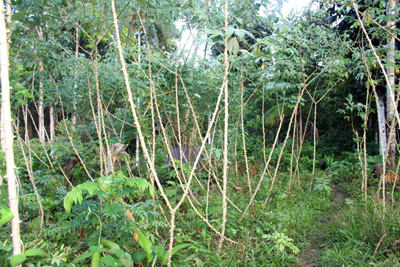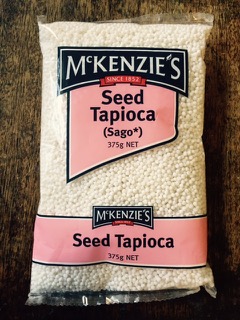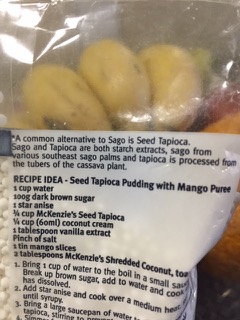You say cassava ...
A Day in the life | Settlers | Hermit | Tapioca/Cassava | Meeting of Waters | Lists | Manaus | M/Y Tucano | Ecology | Maps
 As we were standing next to the settler's little field of manioc (right), I was struck by how similar it looked to the cassava we had seen growing and harvested in Ghana. It looked the same growing, and the sowing process of chopping up a stalk and burying the 9 inch pieces was identical. Not only that, but I remembered that cassava had the same issue with toxins: in some varieties a single plant can contain enough cyanide to kill a cow. Edi: “that’s because manioc is cassava.”
As we were standing next to the settler's little field of manioc (right), I was struck by how similar it looked to the cassava we had seen growing and harvested in Ghana. It looked the same growing, and the sowing process of chopping up a stalk and burying the 9 inch pieces was identical. Not only that, but I remembered that cassava had the same issue with toxins: in some varieties a single plant can contain enough cyanide to kill a cow. Edi: “that’s because manioc is cassava.”
Meanwhile, as Souza explained the manufacturing process, he made the so-controversial observation “manioc is also known as tapioca.” So now manioc is cassava is tapioca. The discussion continued sporadically through the rest of the trip, where the experts and opinionated were forced to debate without the benefit of arbitration from the interweb. So with thanks to Wikipedia, my experiences in Ghana, and the packaging from an Australian grocery product, here I present the definitive explanation, hopefully answering all questions.
Manihot esculenta, with common names cassava, Brazilian arrowroot, manioc, and tapioca, is a woody shrub of the spurge family, Euphorbiaceae, native to South America. It is extensively cultivated as an annual crop in tropical and subtropical regions for its edible starchy tuberous root, a major source of carbohydrates. It is also sometimes called yuca in Spanish, but this should not be confused with yucca, an unrelated fruit-bearing shrub in the family Asparagaceae.
Cassava is classified as either sweet or bitter. Like other roots and tubers, both bitter and sweet varieties of cassava contain toxins, with the bitter varieties containing much larger amounts. Linamarin, an enzyme occurring naturally in the plant, converts the cyanogenic glycoside present in the leaves into cyanide. I did not notice this, but apparently the cassava plant has either red or green branches with blue spindles on them. The root of the green-branched variant requires treatment before consumption, as improper preparation can leave enough residual cyanide to cause sickness, partial paralysis or even death. So I presume that the green-branched varieties are the bitter ones, and that these are what the settlers were farming, but the Ghanaian farmers were using a sweet (red) variety, for which the tubers required less preparation (but you still want to keep the cows from eating the leaves). Farmers often prefer the bitter varieties because they deter pests, animals, and thieves, which also makes sense.
Tapioca is a by-product of manioc flour production. In this process, the wet masa is squeezed (again?) and a starch-rich liquid drains out. This liquid is collected and the water allowed to evaporate, leaving behind a fine-grained tapioca powder similar in appearance to corn starch. Souza showed us a bucket containing this liquid, which is when he made his now famous remark “this will be tapioca.” Where I confess I’m still a little confused is the difference between this liquid and the first liquid which definitely was poisonous, and at what point in the process was this liquid generated?
Commercially, the tapioca starch is processed into several forms: hot soluble powder, meal, pre-cooked fine/coarse flakes, rectangular sticks, and spherical "pearls." Pearls are the most widely available shape; sizes range from about 1 mm to 8 mm in diameter, with 2–3 mm being the most common.
  Images courtesy and © Barb Kennett 2015 |
Rathole: Sago This treatise would not be complete without mentioning sago. Sago is a starch extracted from the spongy centre, or pith, of various tropical palm stems, especially Metroxylon sagu, the true sago palm. The starch pith is taken from the stems and ground to powder. The powder is kneaded in water over a cloth or sieve. It passes into a trough where it settles. After a few washings, the flour is ready to be used in cooking. Sago is sold as flour, or like tapioca, in the form of "pearls". Sago and tapioca are both nearly pure carbohydrate with almost no protein, vitamins, or minerals, much like white rice. Since ancient times, the most common color has been brown/cream, but recently pastel colors have been available. When soaked and cooked, both become much larger, translucent, soft and spongy. Sago and tapioca therefore play pretty much identical roles in the food chain, to the point where they are treated as synonyms, as in this sample Barb sent me. Like cassava (and açaí), sago is a major staple food for many indigenous peoples. Because these people rely on these crops as food staples and because supply is not unlimited, in some areas commercial or industrial harvesting of wild stands of sago-palm can conflict with the food needs of local communities. |
In Brazilian cuisine, tapioca is used for different types of meals. In beiju (or biju), the tapioca is moistened, strained through a sieve to become a coarse flour, then sprinkled onto a hot griddle or pan, where the heat makes the starchy grains fuse into a flatbread which resembles a grainy pancake. Then it may be buttered and eaten as a toast (its most common use as a breakfast dish), or it may be filled or topped with either salgados (salty pastry recipes) or doces (sweet pastry recipes), which define the kind of meal the tapioca is used for: breakfast/dinner, or dessert. Choices for fillings range from butter, cheese, ham, bacon, various kinds of meat, chocolate, fruits such as ground coconut, condensed milk, chocolate with sliced pieces of banana or strawberry, among others. This kind of tapioca dish is usually served warm. At Hotel Tropical these "pancakes" were prepared right in front of us, and pretty much all the options exampled above were available. Watching the short-order cook pour the grains into a circular form on the griddle, and two minutes later be able to flip the fused flatbread never got old.
While there are not a lot of good things that tapioca flour does in the body, there are also not a lot of bad things, either. Tapioca flour is a hypoallergenic food that allows people with food allergies or restricted diets to still enjoy fluffy baked goods. When mixed with other flours such as coconut or almond, tapioca flour can add that fluffy bread goodness that isn’t often present with these “alternative” flours. We saw this fluffiness first hand from the Hotel Tropical pancakes and also Claudia's experiments with gluten-free baking often use flours containing tapioca, and truly the results are excellent.